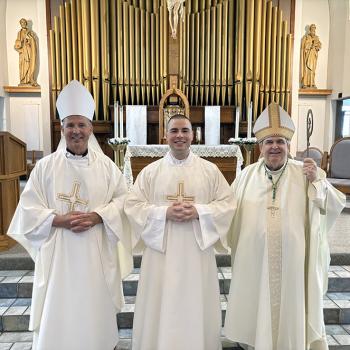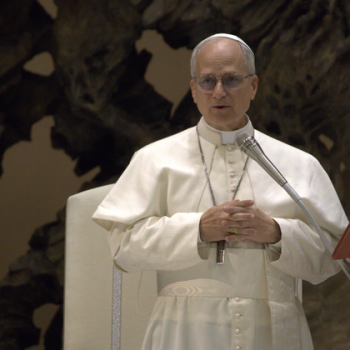Where is God? Why don’t I sense his presence in my life? These questions are ones which we often face. Even those who have had some tangible experience of God one day might suffer from the apparent lack of contact from God for many days or years afterward. If God is acting in our favor, if God is there and willing to meet with us, why don’t we see it? Philip K Dick, after his own unusual mystical experience in 1974, came around to thinking through this very question. The rest of his life, he was trying to understand what really happened, and what the meaning of his mystical encounter was; in his attempt, he has many speculations, some of which are really inspired. One of them deals with this question and how we, at the end of our life, will be able to answer this question better:
What to me is of supreme interest is that the person involved – the subject – would be able to detect the subtle but to him indubitably real hand of the Creator in the final section of his life – although no one else could, and anyone else could argue himself black in the face that no pattern was evident. The subject, all of his life, would have carried these key engrammed-on gestalts, slumbering always in his psyche; he would know, when he began to re-encounter them, what it signified (not that the end was not but that the whole process was subsumed by intention, design, and a plan or Logos). These would be absolute signs along the trail that there was indeed a trail – and it was one intended for him; he and it were isomorphic.[1]
What PKD means here is that there will be events in our lives which will appear quite striking to us, but not others. They will be remembered. They might have helped shape our thinking, but even if not, something later in life will tie in to it, we will remember the events together, and we will see that there is a path which we have been following all along, a path which unites our lives together.
Being a novelist I can appreciate how easily this could be done; the ordinary person would suppose that the tinkering to produce a wholeness would be done at the end (i.e., the final elements in time would be placed there to conform with the very early childhood ones), but of course it’s the other way; at an early age certain gestalts would be stuck in, and at this point the child’s worldview, his sense of reality, would be so hazy that he would accept anything; there could be no rejection of any item as ‘out of context’ or ‘not supposed to be there and hence unconvincing or suspicious in nature.’ God could stick a sardine can in the middle of the sky, and the 2-year-old would gaze at it with awe (as we would) but with total acceptance (which we would not). God could see to it that these key (and they need be only a few) engrammed-on items could be striking – would leave a vivid impression, and a lasting (for obvious reasons) effect. The child, as hew grew up, would find himself wondering, every so often, why the yellow blossoms of the Acacia plant seemed so significant to him and lingered in his memory tapes, after much else had dimmed … and then finally he would delight in re-encountering the Acacia plant, at the Lusitania Hotel, and marvel that he had somehow ‘found his way home’ or better, more accurately, ‘been led home.’[2]
This passage is filled with notions which really helps explains where God is in our lives: he is there, he is always there, and he is there helping make our lives significant. We must, of course, be willing to listen to him, to take the signs and let them lead us to where God wants us to be. If we do, they can bring us to the glory of God, to take in with real awe his ways with us, of how he has always been at work in our lives.
What PKD says here about how God is able to take events in our lives, events which we find significant but others do not, and use them to show his presence is right. Why we like certain things, why we are naturally drawn to certain people or places, are these not places we can see God at work? Nonetheless there are two elements of this which I really appreciate and find significant for a spiritual reflection.
First, it is not just that God is at work, but that he is working on our lives in reverse is a very interesting way of looking at things (and connects to many of PKD’s other theories, such as, often rewrites time when he sees a timeline going astray – while this might sound crazy, in a way, it reflects the notion of Christ being the new and second Adam, and God makes everything old, new). There is significant theological discussion on how God is “coming to us” from “the future.” We think of God as being a God of the past, as a God of our forefathers, but God is much more than that – God is the God of eternity, and eternity is our future goal. In this way God is indeed working at us from the future, and the coming of God in our lives is God coming from the whole of our lives, at the end of them, looking to where he wants to lead us, and providing the means by which we can get there (and, given the room he has made for us with free will, it is likely he has provided many ways for us to get to that end, some better than others, but all of them able to show God at work in our lives if we but stop and look for them).
The second is his discussion of children and how accepting they are of things; it is true they are curious and want to know how things work, why things are as they are – but on the other hand, when they see something, when they are told something, they accept it and then try to understand it. They don’t dismiss things just because they are odd. They don’t go reading into what they see, but they are freer to experience it as it is. This ties to what Christ told us, that we are to come to him like children. If we want to see and experience God, we must be willing to cut off everything which we use to read into the real, and to let the real show itself to us. We must show willingness and trust in God; we can ask why, but we must accept the what. This is harder and harder as we grow old; we grow set in our ways and our worldviews. We must remember, however useful such worldviews are, they are constructs we have created which hinder the real from revealing itself to us. Is there any wonder that we can’t see God if we construct a worldview which doesn’t let his glory in?
Where is God in our lives? PKD has given, at least, a part of the answer. He is at work, showing himself in what might seem to others to be little things, in the subtle clues, which he uses to connect our lives together. That our lives make sense as a whole requires some order, something transcending ourselves; there are too many coincidences which tie our lives together for it to be without some guiding force trying to make it the best it can be. What we experience as a child, what we find inspiring as a child, stays with us, and it is only when we re-encounter it later do we understand why we were drawn to it as a child – we are drawn back home, where we see the presence of God. It is God who makes it of value, it is God who makes it rich, and it is God who makes it a part of our home.















